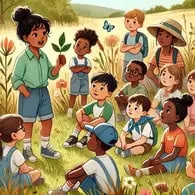Hello, fellow educators and Earth enthusiasts! Welcome back to The Sustainable Classroom Guide.
We often hear what sustainability doesn’t have to be.
- It doesn’t have to be overwhelming.
- It’s not a separate subject.
- It’s not just about big, complex issues.
Today, I want to flip that idea and focus on the exciting “Do’s” of Sustainability in the Classroom.
My goal is to show you that bringing sustainable practices into your K-5 classroom is truly achievable. It’s incredibly rewarding and can fit smoothly into your daily teaching. You won’t need to add a ton of extra work to make a significant difference.
Sustainability DOES Mean Seamless Integration
Forget the idea that sustainability is just another “add-on” to an already busy curriculum. The truth is, sustainability offers a powerful way to make almost any lesson better. It helps learning feel more real, more engaging, and more connected to the world your students live in.
Think about it:
- Math: You can graph classroom recycling habits. Or calculate the energy saved by turning off lights. You can even measure how much a classroom plant grows.
- Literacy: Read stories about nature or environmental heroes. Explore communities working together to solve problems. Talk about characters’ choices and how they affect their environment.
- Science: Discover ecosystems, the water cycle, or how plants grow. Learn about simple machines through the idea of renewable energy.
- Social Studies: Learn about local communities and how they use their environment. Understand global connections through how we use resources.
By simply looking at things a bit differently, you’ll find many chances to include sustainable thinking into your classroom. In fact, you won’t need to create entirely new lessons. Instead, your current curriculum will become more lively and meaningful.
Sustainability DOES Mean Connecting with Nature
Topics like solar panels and wind turbines are fascinating, and they are important! But sustainability in the K-5 classroom doesn’t have to start with complicated energy systems. Often, it begins with something much simpler: helping students truly connect with the natural world.
Encourage your students to be nature detectives!
- Watch the seasons change.
- See a tiny seed grow into a plant.
- Explore the amazing world of insects in your schoolyard.
These everyday natural events are perfect starting points. When children feel wonder and appreciation for the living things around them, they naturally start to understand why it’s so important to protect them. This strong connection builds empathy and a sense of responsibility. These are the true beginnings of sustainable behavior.
Sustainability DOES Mean Starting Simple and Flowing Naturally
You don’t need to become an expert on every environmental issue right away. The best part of sustainability education, especially for young learners, is that it can begin small. Then, it can grow naturally from their own curiosity. It’s about creating a smooth path from connecting with nature to understanding, and then to taking action.
- Start with Wonder: If a child is fascinated by a worm in the compost bin, that’s a chance to talk about soil health, composting, and why healthy ecosystems matter.
- Follow Their Questions: If they ask where their food comes from, that’s your chance to explore local farming, food waste, or healthy eating habits.
- Build on Everyday Observations: Noticing trash on the playground can lead to a discussion about community clean-ups and how to handle waste responsibly.
The key is to let these natural connections guide your teaching. When you give students chances to interact with and observe their environment, you create a rich space for deeper learning about sustainable topics. It’s about encouraging their natural curiosity and letting it lead them to understand their role as caretakers of our planet.
Embrace the “DO’S” of Sustainability
Embracing the “Do’s” of sustainability in your classroom means making small, steady choices. Together, these choices create a powerful impact. It’s about inspiring a generation that feels connected, capable, and ready to build a healthier, greener world. And believe me, seeing your students light up with that understanding is one of the most rewarding parts of this journey.
